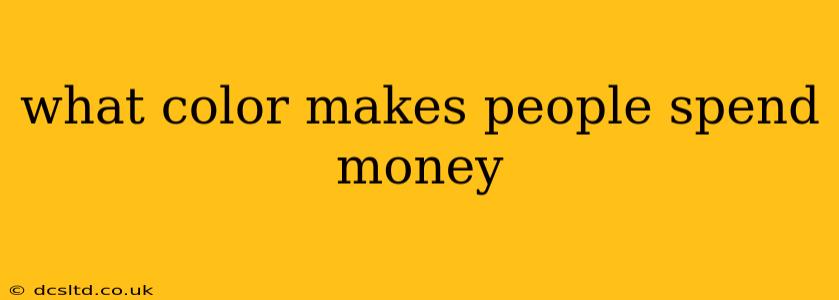What Color Makes People Spend More Money? The Psychology of Color in Retail
The relationship between color and consumer behavior is a fascinating field of study. While there's no single "magic" color guaranteed to make everyone spend more, certain hues consistently influence purchasing decisions. Understanding the psychology of color in marketing and retail can significantly impact your sales strategies. Let's delve into the research and explore which colors are most effective in encouraging spending.
What are the most effective colors for driving sales?
Several studies suggest that red and blue are often top performers. However, the effectiveness isn't universal and depends heavily on the context, target audience, and the specific product.
-
Red: Red is associated with urgency, excitement, and passion. It often triggers a physiological response, increasing heart rate and stimulating the senses. This can lead to impulsive purchases, making it effective for sales and promotions. Think of the ubiquitous red "sale" signs. However, overuse can lead to feelings of anxiety or aggression.
-
Blue: Blue, on the other hand, evokes feelings of trust, security, and calmness. It's often associated with quality and reliability. It's a popular choice for brands aiming to build customer loyalty and project an image of stability. However, it can also be perceived as cold or uninviting if not used correctly.
Other colors play significant roles too, though perhaps less directly related to immediate purchasing:
-
Yellow: This vibrant color often attracts attention and symbolizes happiness and optimism. It can be effective in grabbing attention, but overuse can be overwhelming or even irritating.
-
Green: Green is often associated with nature, growth, and health. It can create a sense of calm and trust, making it suitable for eco-friendly or health-conscious products.
-
Orange: A combination of red's energy and yellow's cheerfulness, orange is often used to convey creativity and enthusiasm. It can be effective for products targeting a younger demographic.
-
Black: Often associated with luxury, sophistication, and power, black can create a sense of elegance and exclusivity. However, it can also be perceived as negative or even aggressive if used improperly.
-
Purple: This regal color often represents luxury and creativity, making it a favorite among high-end brands.
Does color psychology really work?
Yes, the impact of color on consumer behavior is well-documented. Numerous studies in marketing psychology support the idea that color significantly influences purchasing decisions. However, it's crucial to remember that these effects are subtle and often work in conjunction with other factors like product quality, pricing, and branding.
What other factors influence buying decisions besides color?
While color plays a crucial role, many other factors impact spending decisions. These include:
- Pricing: Discounts and perceived value are major drivers.
- Product quality: Customers are more likely to buy high-quality items.
- Branding: A strong brand builds trust and loyalty.
- Marketing messages: Compelling messaging increases sales.
- Customer experience: A positive shopping experience encourages repeat business.
Can color combinations influence spending habits?
Absolutely! The interaction of colors can significantly impact the overall impression and purchasing decisions. For instance, a combination of calming blue and energizing orange can create a sense of balance and excitement. Conversely, clashing colors can be distracting and off-putting.
How can businesses use color psychology to increase sales?
Businesses can use color psychology strategically to improve their marketing and retail strategies. This involves understanding their target audience and choosing colors that resonate with their values and preferences. Careful consideration of color palettes across their branding, website, and physical stores is crucial. A professional designer's expertise can be invaluable in this process.
In conclusion, while no single color guarantees increased sales, understanding the psychology of color and its impact on consumer behavior can be a powerful tool for businesses looking to improve their marketing efforts and boost their bottom line. The key is to use color strategically, considering your target audience, brand identity, and the specific product you're selling.
